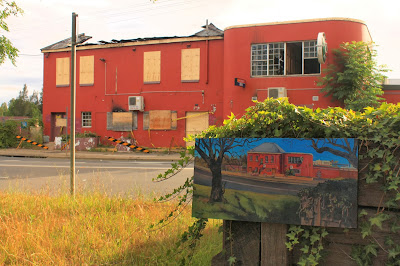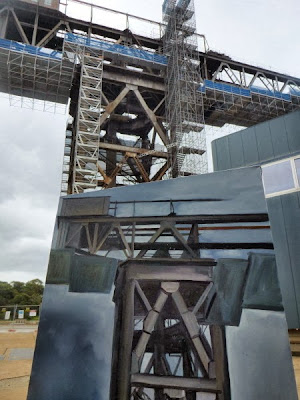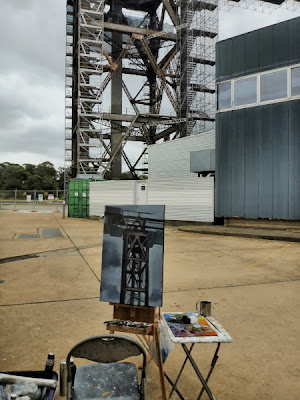I've just read the excellent historical notes on theself-guided Windsor Heritage Walks, that I found in the Macquarie Arms Hotel.
I painted this view from the site of the Windsor Barracks and Guardhouse opposite.
According to the guide "in 1818 a substantial brick barracks accommodating up to 60 soldiers was completed on this site by Richard Fitzgerald. The foundations of the guardhouse constructed in 1830 at the entrance to the barracks were unearthed by roadworks in 1976 and the site preserved. The guardhouse consisted of 3 small cells which were used for the confinement of subordinate soldiers. The site was surrounded by a high wall, remnants of which survive today. The barracks and guardhouse were demolished in about 1928 to make way for the construction of a police station and lockup."
 |
WJF4 'The 'Jolly Frog' from the foundations of the Military Barracks 2013 oil on canvas 31 x 61cm Enquiries |
Whenever I painted the "Jolly Frog" I found myself thinking about Edward Hopper's paintings, while listening to the Buena Vista Social Club on my mp3 player.In Edward Hopper's paintings, encroaching shadows express the tension between nature and culture, and past and present.
Although roads are typically associated with the noise, speed, and rapid change of modern life, this scene is curiously still and silent.
I've finally tracked down the Edward Hopper painting that I feel it most resembles " Early Sunday Morning" 1930.
After crossing the Fitzroy bridge over South Creek, for a minute I thought I had arrived at a sleepy Cuban shanty town. The shabby facade of the "Jolly Frog" painted like a block of liquorice allsorts , a combination of sublime architecture and gorblimey colour evoked the streets of Old Havana.
I've always wondered about the inspiration behind the surprising and lurid colour schemes of moribund pubs.
For comparison, I have included 2 of my paintings of the ex-pub "The Pyrmont Arms".
 |
| "P248A The 'Pyrmont Arms' from the CSR 2 1991 oil on canvas 31 x 31cm Enquiries |
The pink paint job is startling enough on the close up bird's eye view study I painted from the roof of the CSR boilerhouse (now the 'Elizabeth' apartment of the Jackson's Landing LendLease development)
But just look at how it sticks out like a sore thumb amongst all the dark decaying bond stores and warehouses!
 |
| P249 "Pyrmont panorama- from the CSR 2" 1991 oil on canvas 38 x 76cm Enquiries |
Same fabulously horrid "glow in the dark" shade of "Paddo pink", but a very different fate was in store for the ex- Pyrmont Arms Hotel. It is no longer a hotel, but has been reasonably sympathetically renovated and is now a combination of apartments above and a bottle-o below.
The real mystery is how the "Terminus Hotel" a block further south in Pyrmont has so far escaped. The Terminus has been derelict since the mid 1980s, and must surely be a candidate for the Guinness Book of Records for the longest existence as a derelict building without having suffered a mysterious fire. If you're interested in its strange history see my posts in this blog "To the Point" , "Looking over the overlooked" and "A tale of Two Pyrmont Hotels"Update
 |
| WJF4 'The 'Jolly Frog' from the foundations of the Military Barracks 2013 oil on canvas 31 x 61cm Enquiries |
Past and present at the Jolly Frog, 26th January 2014
 |
| WJF4 'The 'Jolly Frog' from the foundations of the Military Barracks 2013 oil on canvas 31 x 61cm Enquiries |
 |
WJF5 'The 'Jolly Frog' (there's nothing...) 2013 oil on canvas 25 x 31cm Private Collection : Windsor Enquiries |
Related posts
See my page of Pyrmont paintings









.jpg)
.jpg)








